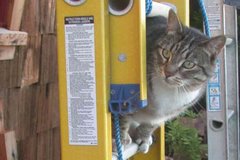seas are ~3m peak to trough today... like 2 days ago, but i have sea
legs now, so i am not sea sick. totally sunny and a great view. we are
a little further offshore than yesterday, so i cannot see land
sticking up over the horizon anymore.
we are making great progress on mapping. yesterday we had to stop for
an hour to wait for some fishing boats to get out of the way and we
had to go back to fill some holidays (areas we did not map) because of
other fishing boats and also our pos-mv (our positioning unit that
tells the mapping/sonar system where we are) went out for a moment.
these delays added several hours to our survey.
here is a pic of me sending out an XBT. we drop this device (lead
'dart' with a copper wire attached) to measure the sound velocity
profile. the sound velocity profile varies with temperature and
salinity primarily. sound velocity is important as the timing of the
sonar pings through the water column is how we can tell where the sea
floor is and therefore how we can map the bathymetry.







